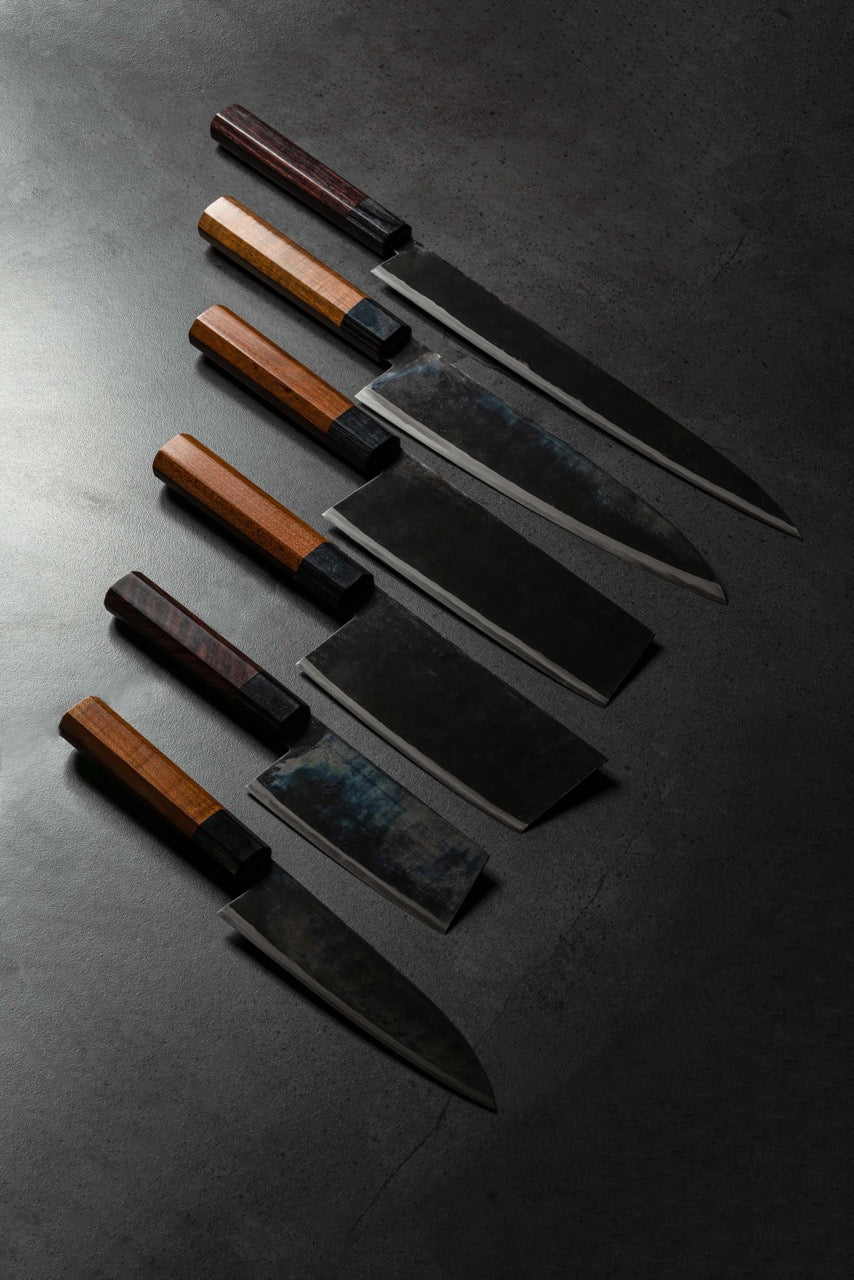
Hitohira Togashi Shirogami #1 Mizu Honyaki Yanagiba 270mm Ebony wood
Please note
Each handle is unique and may feature distinct variations, such as different shades or colors in the buffalo horn, which is part of its authentic, handcrafted character.
Store availability
*Transfer available between stores, contact us at info@staysharpmtl.com or 514-503-1185 (MTL) / 418- 440-7770 (QC)
Description
Yanagiba translates as “willow blade” since the narrow, long and curved blade shape on the back side resembles a willow leaf. The specialty of the Yanagiba is slicing fish in a precise and clean way for cutting sashimi or nigiri for example. It can also be used for filleting certain fishes and slicing meat. The very fine cutting edge can be damaged easily, so we advise you to be careful with bones. The concave back of the knife (urusaki) creates an air gap between the fish flesh and the blade, making it easy to detach the blade from the fish flesh, while the bevel on the face of the knife (shinogi) makes it easy to detach the piece of fish being sliced. The Yanagiba is generally found between 210 mm and 330 mm.
Born in 1948, Kenji Togashi began his career in 1966-67 and received numerous awards over the years. In 1990, he received the Dentō-Kugeishi, granted by the Japanese Ministry of Economy and Trade. This award is reserved for Japanese craftsmen who are masters in their field and have accumulated at least 12 years of experience and proven their mastery of their art, both in theory and in practice. In 2007, the city of Sakai/Osaka awarded him the certification of "Master of Traditional Craftsmanship" for his excellent tempering technique and his exceptional mastery of making kitchen knives that honor the ancestral Japanese forging traditions.
Today, Kenji Togashi makes his knives from start to finish in his workshop in Sakai/Osaka. He works with his three sons and a few apprentices to bring us top quality blades that meet the standards of the master Togashi himself. When you buy a Togashi blade, you are assured of a level of forging, grinding and finishing quality that rivals the best forging houses in Sakai.
Shirogami #1 by Hitachi steel co translates to white steel #1 and is an improved version of Shirogami #2 as it contains a higher carbon content. It is named after the color of the paper in which it is packaged once produced. It is considered one of the purest steels, after Tamahagane, which allows for a sharper edge than most other steels. However, it will generally be more brittle and can break more easily due to misuse. Mastering the forging of shirogami #1 to exploit its full potential is not simple and requires an expertise that few blacksmiths have. It is in the process of making a Mizu Honyaki type knife that you will find the shirogami #1 in its most difficult to forge version, but also the sharpest.
Tips for best results
Make sure your knife will deliver its absolute best by having it professionally sharpened at least once a year. Please note that our meticulously handcrafted Japanese knives are – unless otherwise noted – carbon steel and not stainless steel. To prevent rust, make sure the blades are patted dry – especially when cutting acidic items. Never cut frozen foods, hard products, bone, or twist the blade when using. Never soak in water after use or put in the dishwasher. After use, store in a cool, dry place and avoid high temperature fluctuations.
Our commitment to you – our customers
Warranty
Every knife we carry has a lifetime warranty from manufacturing defects and errors. For example, if the handle becomes detached or cracks appear after a few weeks of proper use. Or if there are any blade cracks from the edge to the spine. While such defects are indeed rare, they can occur. In such cases, we will exchange the knife in question or give you a refund. Each warranty case is different depending on the criteria, and we reserve the right in each and every case to evaluate the applicability of our lifetime warranty in the event of any manufacturing defects and errors.
After-Sales service
Do you get the feeling that your knife just can’t “cut it”?
Each knife we carry is supplied with a so-called “factory edge”. Our chef knife range comprises more than 200 different products. While all our handcrafted Japanese knives ship with a “factory edge”, ultimate blade sharpness can vary. If you feel that your knife’s blade edge is not performing to its full potential, feel free to contact us and we will provide you with professional sharpening for free!
Oops! What about the truly Unthinkable?
Was it just through a slight slip of the hand that your knife accidentally fell on the floor and damaged its tip and blade, or it was used to cut a hard, frozen product and chipped? Don’t despair, get in touch with us and we will solve the problem through our in-house, professional sharpening and repair service.
Simply contact us or visit our store to get a free estimate.










